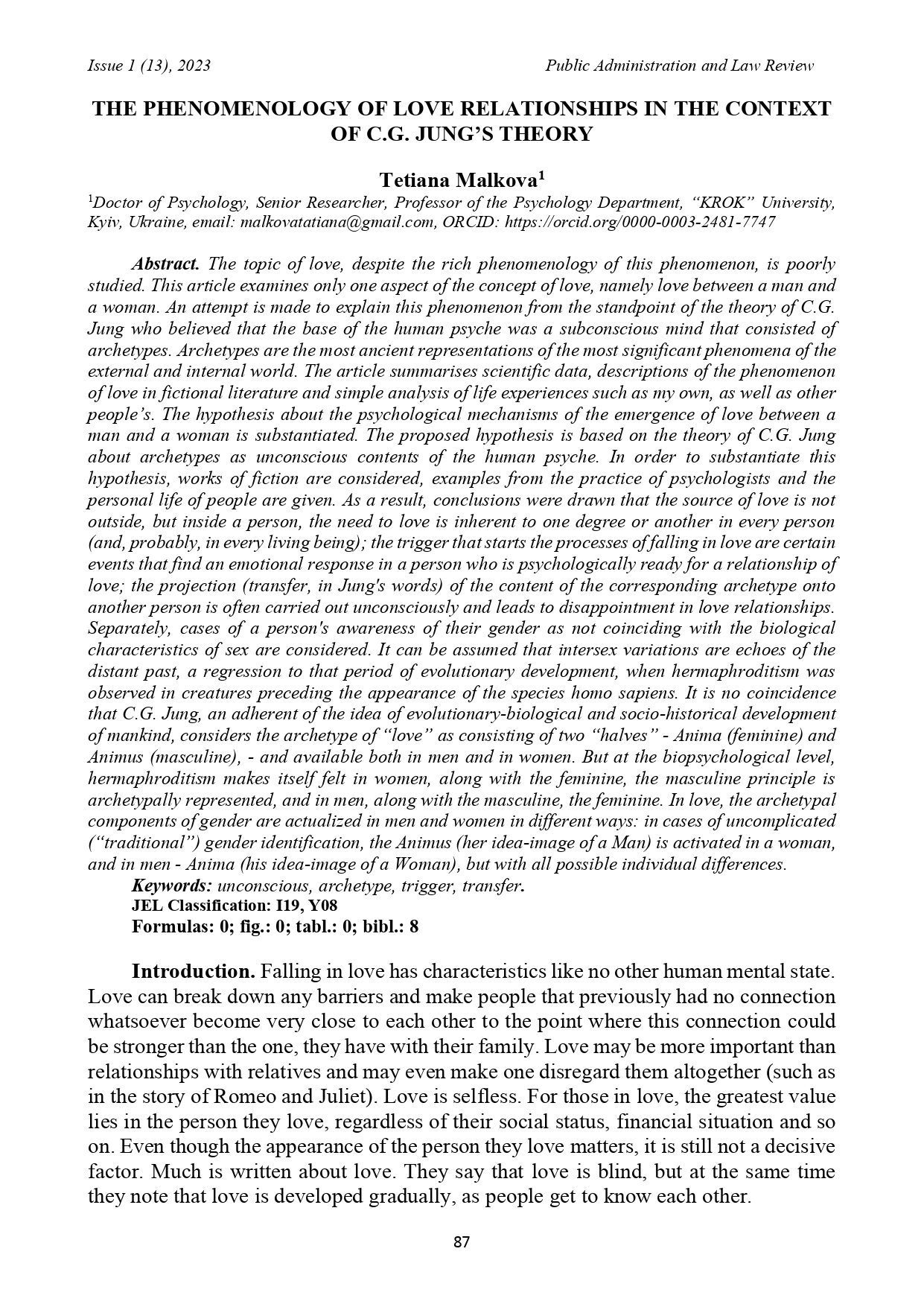THE PHENOMENOLOGY OF LOVE RELATIONSHIPS IN THE CONTEXT OF C.G. JUNG’S THEORY
DOI:
https://doi.org/10.36690/2674-5216-2023-1-87Keywords:
unconscious, archetype, trigger, transferAbstract
The topic of love, despite the rich phenomenology of this phenomenon, is poorly studied. This article examines only one aspect of the concept of love, namely love between a man and a woman. An attempt is made to explain this phenomenon from the standpoint of the theory of C.G. Jung who believed that the base of the human psyche was a subconscious mind that consisted of archetypes. Archetypes are the most ancient representations of the most significant phenomena of the external and internal world. The article summarises scientific data, descriptions of the phenomenon of love in fictional literature and simple analysis of life experiences such as my own, as well as other people’s. The hypothesis about the psychological mechanisms of the emergence of love between a man and a woman is substantiated. The proposed hypothesis is based on the theory of C.G. Jung about archetypes as unconscious contents of the human psyche. In order to substantiate this hypothesis, works of fiction are considered, examples from the practice of psychologists and the personal life of people are given. As a result, conclusions were drawn that the source of love is not outside, but inside a person, the need to love is inherent to one degree or another in every person (and, probably, in every living being); the trigger that starts the processes of falling in love are certain events that find an emotional response in a person who is psychologically ready for a relationship of love; the projection (transfer, in Jung's words) of the content of the corresponding archetype onto another person is often carried out unconsciously and leads to disappointment in love relationships. Separately, cases of a person's awareness of their gender as not coinciding with the biological characteristics of sex are considered. It can be assumed that intersex variations are echoes of the distant past, a regression to that period of evolutionary development, when hermaphroditism was observed in creatures preceding the appearance of the species homo sapiens. It is no coincidence that C.G. Jung, an adherent of the idea of evolutionary-biological and socio-historical development of mankind, considers the archetype of “love” as consisting of two “halves” - Anima (feminine) and Animus (masculine), - and available both in men and in women. But at the biopsychological level, hermaphroditism makes itself felt: in women, along with the feminine, the masculine principle is archetypally represented, and in men, along with the masculine, the feminine. In love, the archetypal components of gender are actualized in men and women in different ways: in cases of uncomplicated (“traditional”) gender identification, the Animus (her idea-image of a Man) is activated in a woman, and in men - Anima (his idea-image of a Woman), but with all possible individual differences.
Downloads
References
“WOMEN’S MAGAZINE” presents: “Conversations with a psychologist”. (2003). Kyiv: LLC Publishing House “Svet”, p. 179.
Somerset Maugham. (1986). Rain. Stories. Lviv: High school. University of Lviv, p. 80.
Maurois, Andre. (1989). Letters to a stranger: selected novels. Lviv: High school. Publishing house at Lviv University, p. 69.
Jung, C. G. (1997). The alchemy of our dreams. St. Petersburg: Timoshka, p. 17.
Jung, C. G. (1995). Tavistock lectures. Analytical psychology: its theory and practice. Kyiv: SINTO, p. 123.
Being Intersex in Russia: A BBC Documentary. URL: http://surl.li/fyfts.
S. Afonkin “And why aren’t we hermaphrodites?” URL: http://surl.li/fyfud.
Kundera M. (2004). The unbearable lightness of being. Novel. St. Petersburg: Azbuka-classica, p. 232.
Honoré de Balzac. (1982). Lost illusions. Novel. Moscow: Pravda, p.121.
Stendhal. Love. URL: http://az.lib.ru/s/stendalx/text_0040.shtml.
M. Komissarova. (2016). Love: the secrets of defrosting. Kaunas Lithuania: Knygų klubas, p. 224.
Spies in the government, syringes of methadone, undercover work. Ex-secret service agent. The Main Directorate of Intelligence. URL: http://surl.li/fyfup.
Stendhal. (1990). The red and the black: A chronicle of the 19 century. A novel. Kyiv: Soviet School, p.125.
Dalai Lama, P. Ekman. (2011). The wisdom of the East and the West. Psychology of equilibrium. St. Petersburg: Piter, pp. 244-250.
Lebon G. The crowd: A study of the popular mind. (1896). St. Petersburg: Edited by F. Pavlenkov. pp. 258-259.

Downloads
Published
How to Cite
Issue
Section
License

This work is licensed under a Creative Commons Attribution-NoDerivatives 4.0 International License.





